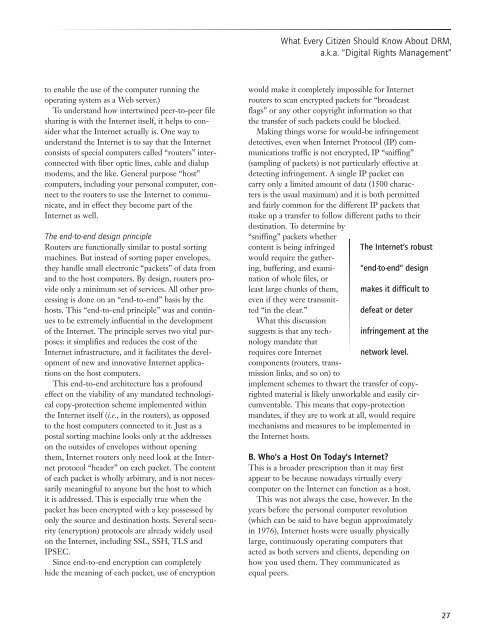What Every Citizen Should Know About DRM, aka - Public Knowledge
What Every Citizen Should Know About DRM, aka - Public Knowledge
What Every Citizen Should Know About DRM, aka - Public Knowledge
You also want an ePaper? Increase the reach of your titles
YUMPU automatically turns print PDFs into web optimized ePapers that Google loves.
<strong>What</strong> <strong>Every</strong> <strong>Citizen</strong> <strong>Should</strong> <strong>Know</strong> <strong>About</strong> <strong>DRM</strong>,a.k.a. “Digital Rights Management”to enable the use of the computer running theoperating system as a Web server.)To understand how intertwined peer-to-peer filesharing is with the Internet itself, it helps to considerwhat the Internet actually is. One way tounderstand the Internet is to say that the Internetconsists of special computers called “routers” interconnectedwith fiber optic lines, cable and dialupmodems, and the like. General purpose “host”computers, including your personal computer, connectto the routers to use the Internet to communicate,and in effect they become part of theInternet as well.The end-to-end design principleRouters are functionally similar to postal sortingmachines. But instead of sorting paper envelopes,they handle small electronic “packets” of data fromand to the host computers. By design, routers provideonly a minimum set of services. All other processingis done on an “end-to-end” basis by thehosts. This “end-to-end principle” was and continuesto be extremely influential in the developmentof the Internet. The principle serves two vital purposes:it simplifies and reduces the cost of theInternet infrastructure, and it facilitates the developmentof new and innovative Internet applicationson the host computers.This end-to-end architecture has a profoundeffect on the viability of any mandated technologicalcopy-protection scheme implemented withinthe Internet itself (i.e., in the routers), as opposedto the host computers connected to it. Just as apostal sorting machine looks only at the addresseson the outsides of envelopes without openingthem, Internet routers only need look at the Internetprotocol “header” on each packet. The contentof each packet is wholly arbitrary, and is not necessarilymeaningful to anyone but the host to whichit is addressed. This is especially true when thepacket has been encrypted with a key possessed byonly the source and destination hosts. Several security(encryption) protocols are already widely usedon the Internet, including SSL, SSH, TLS andIPSEC.Since end-to-end encryption can completelyhide the meaning of each packet, use of encryptionwould make it completely impossible for Internetrouters to scan encrypted packets for “broadcastflags” or any other copyright information so thatthe transfer of such packets could be blocked.Making things worse for would-be infringementdetectives, even when Internet Protocol (IP) communicationstraffic is not encrypted, IP “sniffing”(sampling of packets) is not particularly effective atdetecting infringement. A single IP packet cancarry only a limited amount of data (1500 charactersis the usual maximum) and it is both permittedand fairly common for the different IP packets thatmake up a transfer to follow different paths to theirdestination. To determine by“sniffing” packets whethercontent is being infringed The Internet’s robustwould require the gathering,buffering, and examinationof whole files, or“end-to-end” designleast large chunks of them, makes it difficult toeven if they were transmitted“in the clear.”defeat or deter<strong>What</strong> this discussionsuggests is that any technologymandate thatinfringement at therequires core Internet network level.components (routers, transmissionlinks, and so on) toimplement schemes to thwart the transfer of copyrightedmaterial is likely unworkable and easily circumventable.This means that copy-protectionmandates, if they are to work at all, would requiremechanisms and measures to be implemented inthe Internet hosts.B. Who’s a Host On Today’s Internet?This is a broader prescription than it may firstappear to be because nowadays virtually everycomputer on the Internet can function as a host.This was not always the case, however. In theyears before the personal computer revolution(which can be said to have begun approximatelyin 1976), Internet hosts were usually physicallylarge, continuously operating computers thatacted as both servers and clients, depending onhow you used them. They communicated asequal peers.27





